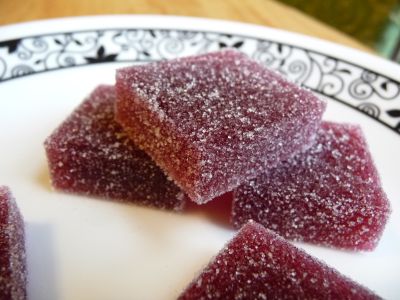Concord Grape Fruit Jellies

This summer has been very rainy around here, so when I asked my favourite fruit vendor at the farmers' market about Concord grapes, they were a little skeptical. "They need more sun! Ideally about 10 days more. Check back in two weeks." Two weeks later, still no grapes. Fortunately, the entire week after that was warm and sunny, so I finally laid my hands on some Concord grapes last weekend.
You may not know it, but you're already familiar with the taste of Concord grapes. Think Welch's grape juice or grape jelly. In fact, given how incredibly "grapey" the flavour is, I have a hard time believing anyone would bother using artificial grape flavouring.
A fresh, whole Concord grape is a slightly different matter. They don't smell like Welch's. They have an aroma that's musky and wonderful and all its own, that can be detected from several stalls away at the market: I knew the grapes were in before I even saw them. These grapes are not the easiest to eat, either, though they taste great. The skins have a tendency to slip off easily, but the flesh clings tightly to the seeds. Yes, grapes with seeds!
We bought 10 litres.
The first 8 were destined for grape jelly, which went off without a hitch. Grape jelly is easy, if you're comfortable making jam: take 4 pounds of grapes and half a cup of water. Crush the grapes and simmer for 10 minutes with the water. Strain through a jelly bag (without squeezing, if you want a clear jelly), then measure out 4 cups of the juice. Put in a pot with 6¾ cups of sugar and bring to a good rolling boil. Then add a pouch of liquid pectin, boil for 1 minute, and pour into sterilized jars and seal. The hardest part is waiting for the juice to strain.
The rest of the grapes were a bit more of a personal challenge. You see, during Concord season last year, I tried to make the grape jellies, also known as pâte de fruit, from The French Laundry Cookbook. I followed the recipe as closely as I could, but the end product was an indistinct mass of grape-flavoured ooze. (Apparently, I'm not the only one to have this problem.)
So I spent the intervening year doing a little research so that I would be ready when grape season rolled around again. I decided that the jellies needed to be cooked to a slightly higher temperature than is specified in the recipe: it calls for 219F, but the consensus seemed to be that 224F was closer to the mark for a standard fruit jelly recipe, so that's what I did.
The end result was certainly far from perfect, but it was a vast improvement over last year. For one thing, this year's batch of jellies can be picked up in your fingers, rather than having to be eaten with a spoon. The flavour is great, but the texture is a little too firm. Next year, I'll try it at 223F and see how it goes. Which really gives me a good reason to look forward to Concord grape season next year!

1 Comments:
At 4:49 PM, Greling Jackson said…
Greling Jackson said…
Try heating them a bit less and adding sodium alginate (a kelp salt). That should give it a bit of jellyness.
Post a Comment
<< Home